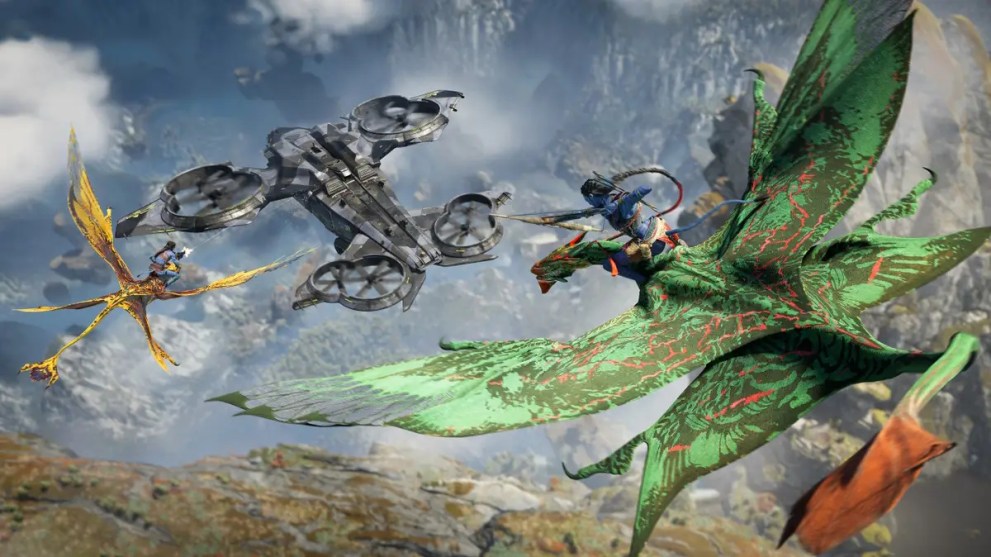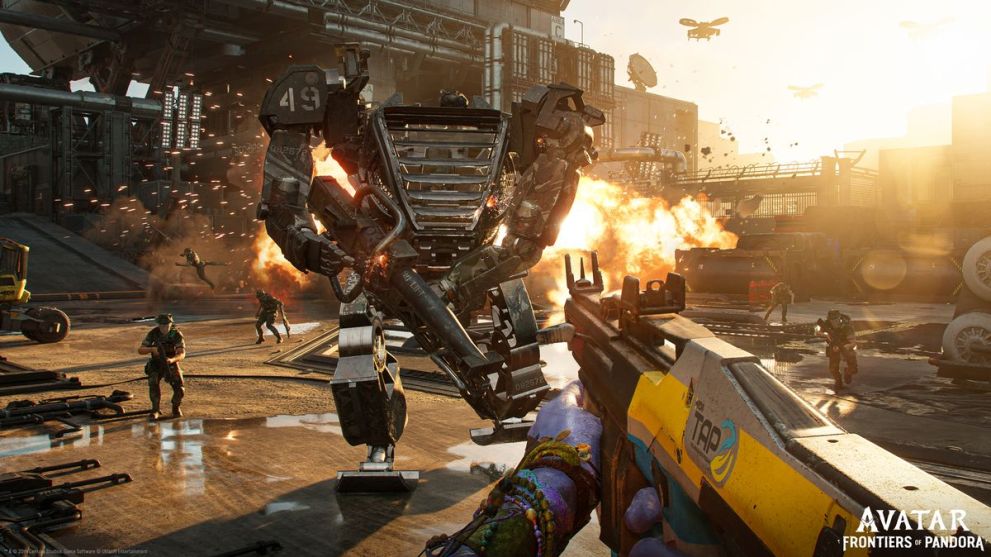Avatar: Frontiers of Pandora on PC
It’s almost shocking how perfectly a moment from my review playthrough of Avatar: Frontiers of Pandora captured the wider experience in a truly poetic fashion.
After a hard-fought battle to free a sturmbeest from RDA forces — complete with stealth kills a la trip mines, long-distance sniping with a heavy bow, and a tense final push with a Na’vi-sized shotgun — it brushed itself off, gave a huff of appreciation to my character, and galloped into the gorgeously detailed greenery of the nearby jungle. As it ran free and without worry, I was really pulled into the themes of cohabitation with nature and hoped it would continue to run wild without issue.
Then, right before successfully escaping, the poor animal triggered a poisonous plant bulb that exploded into a plume of noxious gas, killing it instantly.
Much like this poor dumb creature’s escape attempt, Avatar: Frontiers of Pandora nearly manages to run wild with its ideas and themes but stumbles right before implementing them properly. And, as a result, it doesn’t fully make use of the potential for fun and engagement is so nearly offers.
The game doesn’t do a good job of hiding this fact either. From the get-go, it attempts to build an engaging narrative fit for one of James Cameron’s films, only to fall flat due to some clear pacing issues.
It initially introduces players to a gutting tragedy of a Na’vi tribe wiped out by the RDA — and, more importantly, its children being forced into a facility where they are forced to sympathize with the humans’ goals. The player is one such character, and their sister is killed in front of them for resisting this indoctrination.

Within just a few minutes of this though, two time skips occur in rapid succession. This then brings players to a point where the Navi are actively forming a resistance against the RDA, and they need the player character to carry out raids and gain support from the tribes located in the western regions of Pandora.
It’s jarring to say the least, and the more substantial narrative threads fall by the wayside to make room for poorly paced storylines tied to side characters and twists telegraphed a mile away. Granted, this is largely so that players can more quickly be let loose and roam around the world, but it leaves the overall story feeling half-baked and erratic in its pacing compared to its cinematic counterparts.
The gameplay of Avatar: Frontiers of Pandora also experiences this unfortunate failure to capitalize on its strengths. The majority of the time, the title comes off like an exploration-heavy Far Cry title, but with some extra Avatar-specific gameplay features. There are a metric ton of points of interest for players to track down, and they can be anything from simple collectibles to special side quest markers.
Finding these is necessary to improve their overall effectiveness in combat via health increases, skill points that can unlock new abilities, new weapons to use against RDA troops, and resources that can be used to buy or craft new gear.
There are likewise a plethora of RDA bases and operations for players to capture or destroy in a variety of ways. Doing so nets them everything from weapons to rarer resources, and revitalizes their polluted surroundings so that the nature of Pandora can heal itself.
The game encourages players to explore the world and find these points of interest regularly, and there are a ton of options they can turn to for improving their mobility and traversing this massive sandbox.
On foot, they can sprint and jump around the world with ease, parkouring around environments in a way akin to Mirror’s Edge or Dying Light. They can likewise summon an Ikran to soar through the sky or gallop across the plains via mounts like Direhorses, presenting plenty of strategic options for dealing with threats and platforming challenges.

On paper, it’s a design approach that should be a recipe for success. Unfortunately, Avatar: Frontiers of Pandora is designed in a way that quickly limits these options, and even punishes players for trying to break from the developer-intended method or path.
While players can wander around certain sections whenever they wish, they more often than not must complete several hours worth of slow story missions and tutorials in order to gain full access to everything these areas have to offer. Even then, they won’t be able to do much until they’ve raised their overall level by equipping better gear, which requires yet more story progression or completing restrictive side quests.
The RDA bases are likewise rigid in how you can deal with them. While players can technically clear them out in a variety of ways, a purely stealthy approach is the only way to get all of the rewards found within these points of interest. Failing to clear these facilities without raising the alarm can lock players out of said rewards, making it feel like a punishment if you try to use a method that seems more fun or more viable.
It’s a shame, because the feeling the game was aiming for shined through in the brief moments when I either had some liberty to explore or stopped playing the game the way it was designed to be played.
Roaming freely through the different areas of the game without any quest markers or worrying about progression helped me gain a better understanding of the wider world, and to see landmarks and scenery as more than set dressing for the rest of the gameplay. Clearing out RDA bases guns blazing captured the adrenaline of the films’ action set pieces, and flying from one end of the map to the other atop an Ikran felt like a fan’s dream come to life.

Avatar: Frontiers of Pandora does at least have some saving graces in its audio and visual design. While some of the voice-acting can be hit or miss, the sound effects and music don’t disappoint. Most every track used amplifies what’s occurring on screen, and the constant din of wildlife throughout Pandora does more than a little heavy lifting in helping players to get immersed.
The visuals, meanwhile, are frankly jawdropping. From the textures on the animals, Na’vi, and fauna to the particle and Shadows, the game can be truly breathtaking in motion, and the iconography of the series’ setting and inhabitants is captured perfectly. More than once, I had to stop and gawk at how incredible a Vista was, or how minutely detailed every aspect of a creature or RDA mech was.
With that said though, these visuals can be demanding for your console of choice. In the worst cases, this can mean a chugging framerate as the game tries to display the various effects on screen at once, which can hinder the overall effect.
I really wanted to like Avatar: Frontiers of Pandora more than I did, but the game’s various shortcomings make it difficult to love entirely. The exceptional graphics and brief moments of greatness make it worthwhile for Avatar fans, but most anyone else is likely to be frustrated by how close it comes to doing something special only to fall shy of its potential.
- Great Graphics and Visuals
- Solid Audio Design
- Brief Moments Where the Game Lets You Explore and Experience the World Freely
- Jarring Story Pacing
- Game Railroads You Into Story Content
- Stealth Segments Feel Forced












Updated: Dec 5, 2023 10:18 pm